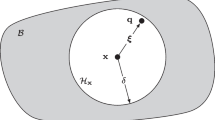Abstract
Usually the notion “Newton-Raphson method” is used in the context of non-linear finite element analysis based on quasi-static problems in solid mechanics. It is pointed out that this is only true in the case of non-linear elasticity. In the case of constitutive equations of evolutionary-type, like in viscoelasticity, viscoplasticity or elastoplasticity, the “Multilevel-Newton algorithm” is usually applied yielding the notions of global and local level (iteration), as well as the consistent tangent operator. In this paper, we investigate the effects of a consistent application of the classical Newton-Raphson method in connection with the finite element method, and compare it with the classical Multilevel-Newton algorithm. Furthermore, an improved version of the Multilevel-Newton method is applied.
Similar content being viewed by others
References
Bathe K-J, Ramm E, Wilson E (1975) Finite element formulations for large deformation dynamic analysis. Int J Numer Methods Eng 9(2):353–386
Bicanic N, Johnson K (1979) Who was ‘Raphson’? Int J Numer Methods Eng 14:148–152
Cash J (1979) Diagonally implicit Runge-Kutta formulae with error estimates. J Institute of Math Appl 24:293–301
Christensen P (2000) Computational Nonsmooth Mechanics. Contact, Friction and Plasticity. Doctoral thesis, Department of Mechanical Engineering, Linköping University. Linköping Studies in Science and Technology, No.657
Davis T, Duff I (1997) Umfpack version 2.2 unsymmetric-pattern multifrontal package. http://heron.cc.ukans.edu/software/umfpack
Eckert S, Baaser H, Gross D, Scherf O (2004). A BDF2 integration method with stepsize control for elastoplasticity. Comput Mech 34: 377–386
Ellsiepen P, Hartmann S (2001) Remarks on the interpretation of current non-linear finite-element-analyses as differential-algebraic equations. Int J Numer Methods Eng 51:679–707
Fritzen P (1997) Numerische Behandlung nichtlinearer Probleme der Elastizitäts- und Plastizitätstheorie. Doctoral thesis, Department of Mathematics, University of Darmstadt
Golub G, van Loan CF (1986) Matrix Computations. North Oxford Academic Publ., London
Hartmann S (1998a) Nichtlineare Finite-Elemente-Berechnung angewendet auf ein Viskoplastizitätsmodell mit Überspannungen. In: Hartmann S, Tsakmakis C, (eds) Aspekte der Kontinuumsmechanik und Materialtheorie. Gesamthochschul-Bibliothek Verlag, Kassel, pp. 55–80
Hartmann S (1998b) Zur Berechnung inelastischer Festkörper mit der Methode der finiten Elemente. In Hartmann S, Haupt P, Ulbricht V, (eds) Modellierung und Simulation. Gesamthochschul-Bibliothek, Kassel pp. 119–130
Hartmann S (2002) Computation infinite strain viscoelasticity: finite elements based on the interpretation as differential-algebraic equations. Comput Methods Appl Mech Eng 191(13–14):1439–1470
Hartmann S (2003a) Finite-Elemente Berechnung inelastischer Kontinua. Interpretation als Algebro-Differentialgleichungssysteme. Technical Report 1/2003, University of Kassel, Institute of Mechanics, Kassel, Germany
Hartmann S (2003b) On displacement control within the DIRK/MLNA approach in non-linear finite element analysis. In: Bathe K-J (ed) Comput. Fluid Solid Mech. 2003, volume 1. Elsevier, Amsterdam pp. 316–319
Hartmann S, Lührs G, Haupt P (1997) An efficient stress algorithm with applications in viscoplasticity and plasticity. Int J Num Methods Eng 40:991–1013
Hibbitt H, Marcal P, Rice J (1970) A finite element formulation for problems of large strain and large displacement. Int J Solids Struct 6:1069–1086
Hoyer W, Schmidt J (1984) Newton-type decomposition methods for equations arising in network analysis. ZAMM Zeitschrift für Angewandte Mathematik und Mechanik 64:397–405
Hughes T, Pister K (1979) Consistent linearization in mechanics of solids and structures. Comput Struct 8:391–397
Lührs G, Hartmann S, Haupt P (1997) On the numerical treatment of finite deformations in elastoviscoplasticity. Comput Methods Appl Mech Eng 144:1–21
Press W, Teukolsky S, Vetterling W, Flannery B (1992) Numerical Recipes in FORTRAN. Cambridge University Press, Cambridge, 2nd edn.
Rabbat N, Sangiovanni-Vincentelli A, Hsieh H (1979) A multilevel Newton algorithm with macromodeling and latency for the analysis of large-scale nonlinear circuits in the time domain. IEEE Trans Circuits Sys 26:733–740
Scherf O (2000) Numerische Simulation inelastischer Körper. Fortschritt-Berichte VDI, Reihe 20 (Rechnerunterstützte Verfahren) Nr.321. VDI-Verlag, Düsseldorf.
Simo J, Taylor R (1985) Consistent tangent operators for rate-independent elastoplasticity. Comput Methods Appl Mech Eng 48:101–118
Weber G, Anand L (1990) Finite deformation constitutive equations and a time integration procedure for isotropic, hyperelastic-viscoplastic solids. Comput Methods Appl Mech Eng 79:173–202
Wittekindt J (1991) Die numerische Lösung von Anfangs-Randwertproblemen zur Beschreibung inelastischen Werkstoffverhaltens. Doctoral thesis, Department of Mathematics, University of Darmstadt.
Author information
Authors and Affiliations
Rights and permissions
About this article
Cite this article
Hartmann, S. A remark on the application of the Newton-Raphson method in non-linear finite element analysis. Comput Mech 36, 100–116 (2005). https://doi.org/10.1007/s00466-004-0630-9
Received:
Accepted:
Published:
Issue Date:
DOI: https://doi.org/10.1007/s00466-004-0630-9




